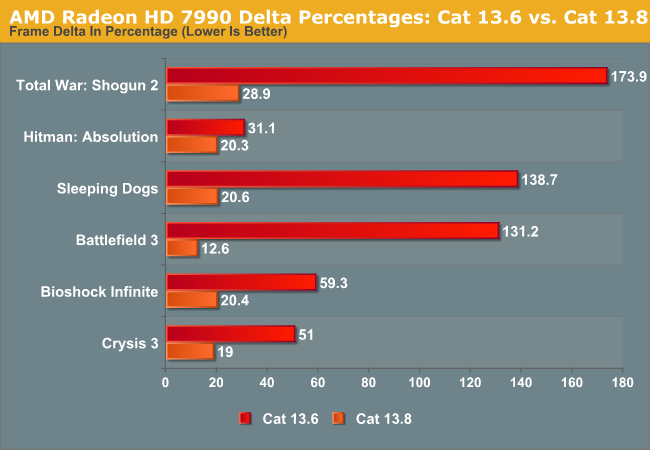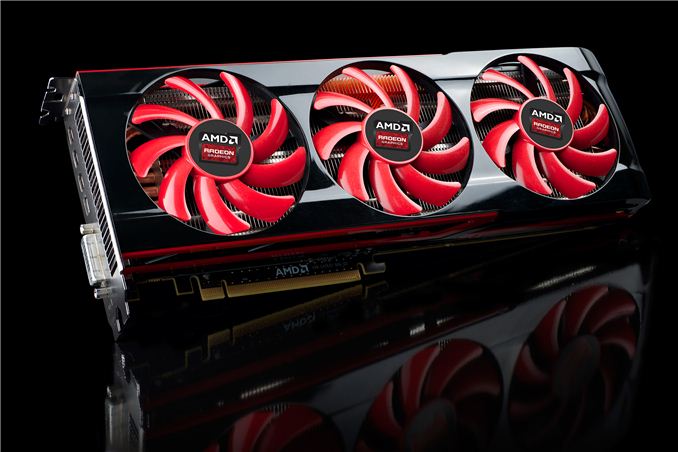AMD Frame Pacing Explored: Catalyst 13.8 Brings Consistency to Crossfire
by Ryan Smith on August 1, 2013 2:00 PM ESTFinal Words
Bringing things to a close, today’s driver release isn’t about any grand revelations for AMD, but rather about AMD following through on their plans and commitments to improve frame time consistency on their products. We’ve seen AMD get their house in order with respect to single-GPU cards earlier this year, and now the same is starting to happen for multi-GPU setups.
To be clear here AMD’s initial situation should never have happened. AMD should have been doing the appropriate competitive analysis from the start, never letting themselves fall behind like this. But we aren’t in the business of berating companies that make an honest effort to improve their products like AMD is doing, so while AMD could have done better in the past they are finally making the right moves in the present, and it’s the present that’s going to be the most important for AMD’s customers.
So what does AMD’s present look like? Quite frankly, it looks a lot better than it did yesterday. AMD set out to greatly improve on their frame pacing situation on their Crossfire setups and they have delivered just that. With just one driver revision we have seen the Radeon HD 7990’s frame pacing go from laughable to acceptable; delta percentages of over 100% have been reduced to 20% or lower in 5 of the 6 games we’ve tested. For those sensitive to micro-stutter and other matters of consistency the difference is at times going to be staggering. At the most basic level, AMD has achieved their objectives.
With that said, there’s still room for improvement, and this goes for both functionality and further improvements in frame consistency. AMD’s triage-like approach means that D3D9, OpenGL, and most importantly Eyefinity are still not capable of using frame metering. These will be covered in future phases of AMD’s rollout of their frame pacing technology, and they can’t come soon enough, but for the time being these are limitations that need to be kept in mind.

Similarly while AMD’s frame pacing has improved to the point where we find it acceptable, 20% deltas are still generally twice that of NVIDIA’s GeForce GTX 690, never mind the extreme consistency single-GPU setups offer. We never realistically expected AMD to match NVIDIA’s frame interval consistency overnight, but in time it would be nice to see them get close, and for both parties to further improve beyond that.
Moving on, while today’s driver release is primarily one part of AMD’s longer term plan to deal with frame interval consistency, AMD is trying hard to also use this moment as something of a second launch for the Radeon HD 7990. With the 7990 launching in April it had the poor timing of arriving shortly after the multi-GPU frame pacing issue came to a head, which is something that has hobbled the card since its launch. In terms of absolute performance (average frame rates) things have changed very little since the launch of the 7990 so we’re not going to get into the matter of performance.
What has changed since then for the 7990 is first and foremost its frame pacing improvements as we’ve seen today. To be very clear here the GTX 690 is still the better card for those users heavily concerned about consistency, but AMD’s improvements have brought the 7990 to the point where we find its frame consistency generally acceptable. This isn’t a rousing recommendation nor is it meant to be, but it’s a reflection of the fact that AMD has brought their consistency to the point where pairing up multiple Tahiti GPUs as is done in the 7990 is no longer fraught with the frame pacing problems it once was. For most users I believe we’re to the point where the consistency differences are greater on paper than they are on the eyes, but of course that is going to depend on the visual acuity of the user.

Moving on, the other thing that has changed for AMD is pricing and competitive positioning. Officially AMD hasn’t cut the price on the 7990, but the fact that XFX is now offering a reference 7990 for $799 after rebate is not a coincidence. With AMD’s Level Up with Never Settle Reloaded promotion still running, AMD is making a clear play for the value segment right now. I don’t believe it’s where AMD would like to be, but there’s no arguing that it’s effective. For users who have a reasonable level of faith in Crossfire scaling and are satisfied with AMD’s frame pacing improvements, a $799 7990 is a very good deal at the moment.
With that in mind, we do want to reiterate that our editorial position here on AFR setups isn’t changing. We still favor strong single-GPU setups over weaker multi-GPU setups, but this is a matter of valuing the lack of AFR profile requirements, coupled with the tendency for newly launched games to have immature AFR profiling, and of course the general consistency issues we’ve covered today. AFR is still the only way to further improve performance once the single-GPU route has been exhausted, and in AMD’s case it’s the only way to exceed the performance of a 7970 GHz Edition, so it does have its place.
Ultimately we have to give AMD the kudos they deserve. They have come forward about their issues, set out a plan to fix them, and have begun delivering on those plans. There’s still room for further improvement within AMD’s drivers, so AMD’s job is far from done, but today they have taken the first step needed to settle the frame pacing problems that have been dogging their products.










102 Comments
View All Comments
chizow - Friday, August 2, 2013 - link
Agree for the most part, but I wouldn't go as far to say boycott AMD, I'd say it's a good learning experience for AMD fans. In order to better their own products, they need to be forthcoming and honest about their experiences. If something's broken, demand a fix, don't sit there and dismiss or minimize the problem, or worst, deflect the issue toward the competition in denial. In the end, they just end up hurting themselves by gimping the products they enjoy.Will Robinson - Tuesday, August 13, 2013 - link
Please go back to spamming the comments section at Tech Report with your NVDA shill buddy Wreckage.Its beyond boring having to read it here too.
chizow - Friday, August 2, 2013 - link
Tom Petersen, Technical Marketing Director for Nvidia, has stated Nvidia has had built-in frame metering provisions since at least G80. Nvidia invented modern day AFR and they have clearly put a lot of thought behind it with the science to back it up. Every time you see them talk about AFR/microstutter/runtframes you see a lot of detailed technical slides and backup. Not so much from AMD. It should be obvious why Nvidia has had less of an issue with microstutter, they actually knew what they were looking to fix.http://techreport.com/review/22890/nvidia-geforce-...
"Nvidia's Tom Petersen threw us for a loop by asserting that Nvidia's GPUs have had, since "at least" the G80, a built-in provision called frame metering that attempts to counteract the problem."
Sabresiberian - Thursday, August 1, 2013 - link
Tech Reports is a competing company to AMD?While it is very good to see AMD making progress here, it is far from over for both AMD and Nvidia. Both companies have work to do to get frame rates to be consistent and high.
BryanDobbins - Saturday, August 17, 2013 - link
my neighbor's mom makes $72/hour on the internet. She has been unemployed for 7 months but last month her pay check was $19114 just working on the internet for a few hours. Read more on this web site... http://goo.gl/qHdAQ4Mondozai - Thursday, August 1, 2013 - link
Always liked Ryan's articles but I hope he gets to write more for this site in the future. For example, he should write more about mobile GPU's now that that area is gaining importance(this year we get to see PowerVR's newest generation, Rogue and next year we get to see Kepler in Tegra 5). Yet he didn't write anything on Tegra 5's Kepler story on this site even if he is the expert on GPU's.Doing a story on AMD drivers is all well and good but honestly, would like to see moar.
Ryan Smith - Thursday, August 1, 2013 - link
We have some in-depth mobile coverage scheduled for later this year, though I can't go into any more detail on it at this moment.mwildtech - Thursday, August 1, 2013 - link
Great write up! Thanks Ryan!SeeManRun - Thursday, August 1, 2013 - link
It wasn't totally clear from reading, but is there any point in upgrading to this driver if you have a single graphics card? It doesn't appear so.DanNeely - Thursday, August 1, 2013 - link
Release notes aren't out yet; but the 3rd page mentions that it adds full OpenGL ES 3.0 support as well as other not yes specified improvements. Most likely they include the obligatory few games to get a performance boost; but it's not purely a crossfire update.